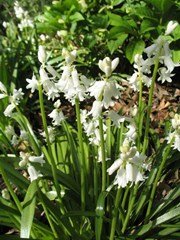Culture
Easily grown in average, medium moisture, well-drained soil in full sun to part shade. Prefers sandy well-drained soils. Avoid unamended clay soils. Tolerates shady conditions. Perhaps best in sun-dappled part shade. Plant bulbs about 3-4” deep and 4-6” apart in the fall. Naturalizes well by both bulb offsets and self-seeding in optimum growing conditions. Plants go dormant by early summer. Plants of this species (English bluebells) will hybridize with plants of Hyancinthoides hispanica (Spanish bluebells) if planted near each other, resulting in different forms appearing through self-seeding.
Noteworthy Characteristics
Hyacinthoides non-scripta, commonly called English bluebell, is a bulbous perennial that is native to open woodland areas of western Europe including, of course, England. Each bulb produces a small clump of linear, strap-shaped, acute-tipped, basal leaves (3-6 per bulb) from which rises in spring (April-May) a 12-15" tall rigid flower stem topped by an arching terminal, one-sided raceme of 4-16 fragrant, pendant, narrow-tubular, bell-shaped, deep violet blue flowers (each to 3/4" long). Each flower has six petals fused together to form a narrow almost straight-sided bell with slightly rolled back petal tips. English bluebell is very similar to Spanish bluebell except English bluebell has fragrant flowers, arching flowering racemes, and shorter flowering stems.
